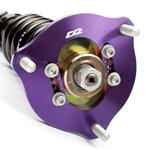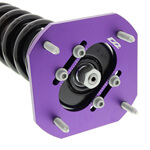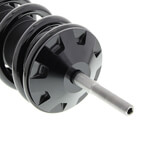- WHAT IS A COILOVER?
- HOW DO I ADJUST MY RIDE HEIGHT?
- HOW DO I ADJUST THE 36-WAY DAMPING ON MY COILOVERS?
- HOW DO I PRELOAD THE SPRINGS ON MY COILOVERS?
- WHY DON'T MY COILOVERS HAVE CAMBER PLATES AT THE TOP?
- WILL I LOSE SHOCK TRAVEL BY LOWERING MY CAR?
- HOW DO I CARE FOR MY COILOVERS?
- I SOMETIMES HEAR A CLUNKING NOISE FROM MY COILOVERS. WHAT IS THAT?
- I LOST OR BROKE A PART ON MY COILOVER KIT. DO YOU SELL REPLACEMENTS?

A coilover is an automobile suspension device. “Coilover” is short for “coil spring over shock”. It consists of a shock absorber with a coil spring encircling it. The shock absorber and spring are assembled as a unit prior to installation, and are replaced as a unit when the shock absorber has leaked. This provides for optimal damping without torsional loads.
D2 Racing offers one of the world’s largest variety of coilovers for any car brand and/or model, starting from the Street versions to Super Racing types. Depending on the user’s demands, D2 is able to develop any coilover system, for any car, under any circumstance, whether you use your car on street, track, rally or drift.
The Shock Body
At the heart of the full-bodied coilover is the shock. Like any shock, the coilover’s upper mount connects directly to the chassis while its lower mount connects to its lower A-arm in double wishbone layouts or the knuckle itself in MacPherson strut configurations.
Shocks control unwanted spring oscillations and reduce vibrations caused by the wheels and chassis. When you hit a bump, the suspension’s springs compress and decompress, absorb vibrations and transfer energy to the shocks through their upper mounts, into their pistons. As a result, the shocks dampen the vibrations, making that bump virtually unnoticeable. The degree to which all of this happens depends on the shock’s internals: stiffer shocks slow spring movement while softer shocks do the opposite.
Shocks do more than just reduce vibrations and control spring movement, though; they also eliminate rocking, pitching, dipping, wheel spinning and all sorts of other things that aren’t supposed to happen when turning or stepping on the gas or brake.
Inside the shock lies a hydraulic fluid-filled tube and piston. The piston pushes high-pressure fluid through the shock’s valves, controlling how it responds against the spring. Kinetic energy harnessed through suspension movement turns into heat energy that ultimately dissipates within the shock’s fluid. Valving is based upon small orifices perforated into the shock’s piston that allow hydraulic fluid to bleed through as the piston travels up and down.
Springs
Springs are divided in 2 basic types, linear and progressive. A progressive spring has a variable spring rate, depending on the amount of load place on the spring. D2 like OEM vehicles provide linear springs, this means that each spring has a fixed spring rate based on the specific kit they are designed for. The performance are more consistent as the driver can better anticipate the suspension movement.
Each coilover kit has specific spring rates, designed to fit the shocks of the coilovers kits. They have been made to absorb the impact of the road condition. In the combination of the shock absorber, they make sure the tires keep in contact with the road. Their design has been calculated with a high degree of accuracy, using theoretical models.
Top Mounts
Pillowball top mount is racing performance product purpose so it is easy to creating some shock noise under some circumstances. Some people do care about the unusual sound made by the pillowball top mount, the pillowball rubber top mount is the best choice as it is able to reduce the unusual sound made by the pillowball top mount.
Combined the handling of pillowball top mount and the comfort of stock top mount.
Topmount legend
| A | P | P+ / P+R | PP | OE |
|---|---|---|---|---|
 |
 |
 |
 |
 |
| Aluminium | Pillowball | Pillowball and Rubber | Pillowball 3D | No Top Mount |
Please note: shape varies depending on car model

The ride height on the majority of our coilovers is designed to be adjusted through the lower mount, NOT by turning the spring perch. The lower mounts are installed on the bottom of the threaded shock body. As you spin the lower mount further onto the shock body, you are shortening the overall length of the entire coilover assembly, which results in a lowered vehicle ride height. Once you have turned the lower mount to your desired setting, tighten the locking collar against it to lock your settings in place. To raise your car, twist the lower mount counterclockwise making the overall length of the coilover longer, thus resulting in a higher ride height. For safety reasons, always make sure at least 30% of the lower mount is threaded onto the shock body. This design is extremely beneficial to performance enthusiasts and those looking to get the most out of their suspension tuning as it allows you to raise and lower your vehicle without interfering with the shock’s compression or travel characteristics. Certain applications are not designed to have an adjustable lower mount and are raised or lowered by adjusting the spring perch. In most cases, a helper spring is present to ensure proper adjustability without sacrificing ride quality. To adjust the ride height, lower the spring perch assembly by twisting it counterclockwise and giving the assembly more room to compress, resulting in a lowered ride height.
D2 Racing coilovers feature 36-way damping adjustable shocks which allow you to fine tune them to your specifications. For coilovers that feature non-inverted shocks, the damping can be adjusted at the top of the coilover assembly. For coilovers featuring inverted shock assemblies, the damping settings can be adjusted from the bottom of the coilover. To adjust, insert the provided damping adjustment knob and turn it left or right to adjust from H (Hard) to S (Soft). You will feel the knob “click” with each turn, indicating one step up or down the 36 way adjustable range.
The springs on your full coilover should already be preloaded out of the box (Always verify this prior to installation). The spring itself should be snug up against the top of the coilover and the locking perches at the bottom should be snug up against the bottom of the spring. The spring should not have any free play or be able to move up or down. Do not crank down on the spring and cause it to compress as this can result in an unpleasant ride quality.
Only cars with MacPherson style suspension are designed to have camber plates accessible at the top of the coilover. On most other non-MacPherson style applications, camber should be adjusted through the use of a separate upper or lower camber kit.
No. Our coilovers feature a fully adjustable lower mount which allows you to raise or lower your vehicle without affecting the shock’s travel or compression characteristics. This design is very advantageous over cheaper suspension kits which use the spring itself to adjust ride height, which can cause premature shock failure and terrible ride quality.
We recommend to routinely inspect your coilovers as you would various other aspects of your vehicle. It is especially important to inspect them and keep them clean if you live in climates that experience heavy winters or rainfall. Over time, debris and dirt can accumulate on the coilover assembly and threads which can cause problems in the future when you want to adjust them. If you feel your coilovers need to be cleaned off, we recommend using a non-corrosive cleaning spray that can be purchased here
Coilovers for cars with McPherson style suspension have metal pillowball bearing upper mounts. Due to the metal on metal contact within the bearing, there is sometimes an audible noise that can be heard. We recommend lubricating the pillowball mount with the included bearing grease or a non-corrosive penetrating lubricant when you first install the coilovers.
We do offer a wide selection of replacement parts which can be purchased directly from us. Send an email inquiry and be sure to include your car’s Make, Model, Year, which type of coilover kit you have, and which specific part you need.
